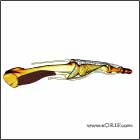 |
synonyms:MTP instability, MTP subluxation, MTP dislocation Metatarsophangeal Instability ICD-10
Metatarsophangeal Instability ICD-9
Metatarsophangeal Instability Etiology / Epidemiology / Natural History
Metatarsophangeal Instability Anatomy
Metatarsophangeal Instability Clinical Evaluation
Metatarsophangeal Instability Xray / Diagnositc Tests
Metatarsophangeal Instability Classification / Treatment
Metatarsophangeal Instability Associated Injuries / Differential Diagnosis
Metatarsophangeal Instability Complications Metatarsophangeal Instability Follow-up Care Metatarsophangeal Instability Review References
|
